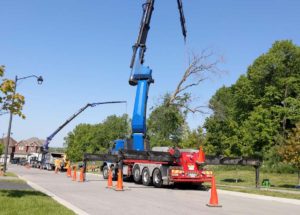Just as trees make our houses with the lumber they provide; they also provide homes to countless creatures. Birds, small mammals, and bugs all enjoy the lovely shelter of broad canopy. However, some of those insects are harmful pests who enjoy your tree a little too much. An infestation of these residents can damage your favorite tree, make it ill, and even kill it. The same pests can also be a nuisance to you and your family while enjoying your yard, so if you spot an infestation, contact Advanced Tree Care for our pest control services.
However, with so many potential inhabitants and many of those being beneficial to your tree, it can be hard to determine if you have an infestation and what kind. Here are some of the main Ontario insects that can harm your trees, how to recognize them, and how to rescue your trees from their attacks.
Aphids
Aphids are one of the most common and destructive pests that will harm your trees. These small green, black, and brown bugs harm trees and plants by sucking sap from the leaves, robbing it of nutrients and slowly killing the leaves which reduces the tree’s food production. That feeding also exposes the tree to viruses. Aphids are stubborn foes; they reproduce incredibly quickly because they are all female and born pregnant. They create a telltale honeydew sap on leaves, which attracts other pests, such as wasps and ants who help the aphids spread. That honeydew will also develop into mold that will further harm your tree. A minor infestation can be removed with spraying the tree’s leaves in the morning, but a more serious infestation can take a professional’s expertise.
Borers
Ontario has three prominent borers who will harm your trees: the Bronze Birch Borer, Bronze Poplar Borer, and Emerald Ash Borer. As their names suggest, each targets a specific tree species. Borers are named for their reproduction method, where they bore into a tree to lay their eggs. When the larvae hatch, they burrow further into the tree’s center, its heartwood. The larvae then feed on the nutrient layer, creating tunnels. These tunnels sever the nutrient path so that essential nutrients cannot travel up the tree. This causes stress and kills the tree, tips down.
Each borer has its own indications. Puffed bark, D-shaped holes, and thinning leaves on top of the tree suggest borers are harming your birch. Poplar borers have recognizable 4cm white larvae and their zigzag tunnels underneath the bark. If you have ash trees, it will be difficult to determine if they have borers. The symptoms often appear too late for the tree to survive, so to protect them from harm, make sure you have the trees treated by a professional. If you think there is a healthy looking ash in your yard, reach out. It will only be a matter of time before it becomes infested.
Eastern Tent Caterpillar
The eastern tent caterpillar is famous for the ugly silken “tents” they create on major branches. These tents are large, white, and swarming with small, black caterpillars. When ready to metamorph, the caterpillars climb to lower branches to build cocoons. These should be destroyed to prevent reproduction. These caterpillars are usually small in number and won’t cause significant damage to your trees. They can easily be controlled by pruning the select branches with tents. However, every few years they can surge in numbers, completely overrunning trees. At that point, you should contact a tree care professional to prevent the caterpillars from causing serious harm to your trees.
Asian Longhorned Beetle

The Asian Longhorned Beetle deserves a special mention. This invasive species first came to Ontario in 2003 and was quickly exterminated. Unfortunately, it returned 10 years later and has seemingly been eradicated in 2021. However, close monitoring for this pest is essential. The Asian Longhorned Beetle devastates Ontario trees, particularly maples. They carve deep holes over a centimeter in diameter into the tree’s heartwood for their larvae, which then further carve away at the tree’s insides. With no natural predators, they are free to harm entire forests. Do not underestimate this pest. If left to spread, they are predicted to cost billions of dollars of damage and potentially destroy the maple syrup industry. If found, this beetle must be removed by a tree care professional, who have specialized injectables to ensure their proper eradication.
Rescuing Your Trees from Bugs
This should help you find some of the most nefarious pests that will harm your trees. There are plenty of others, and many are difficult to identify. That’s why it is best to have your trees regularly serviced by certified tree care professionals like the team members of Advanced Tree Care. If you need help determining a pest, contact Advanced Tree Care for our tree care consulting services and our pest control services. If you believe you may have an Emerald Ash Borer or Asian Longhorned Beetle infestation, we have a specialized formula to safely treat and save your trees.






